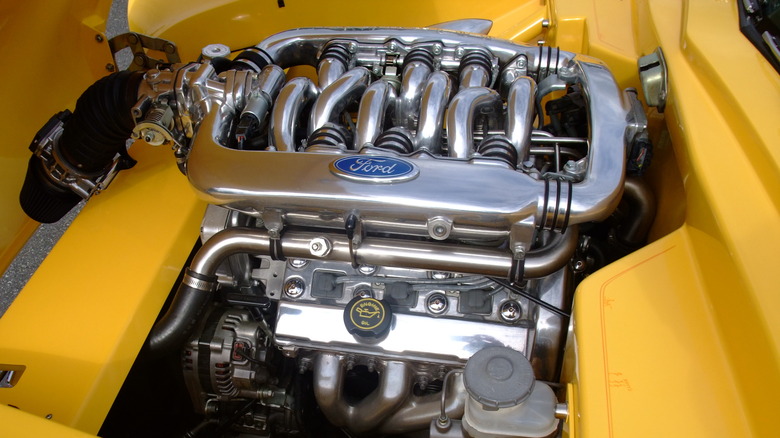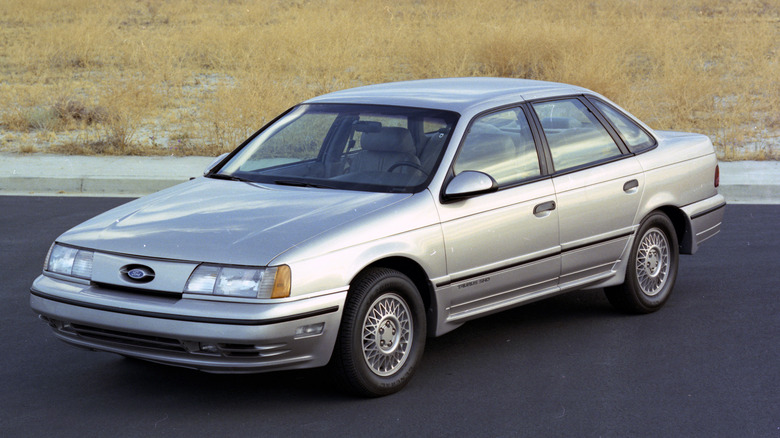Here's What Made The Ford Taurus SHO V6 Engine So Special
In the early-1980s, Ford was secretly developing a mid-engine supercar to blow the doors off of foreign makes like Ferrari and Porsche. Not wanting to use something as mundane as Ford's contemporary 5.0 liter V8, engineers consulted with Japanese motorcycle and outboard motor manufacturer Yamaha to develop a high-performance V6 engine based loosely on an engine that was already in development, called the Vulcan.
Besides having the X factor of not being a standard-bearer V8, a smaller six-cylinder would be easier to mount transversely into the mid-engine sports car, as well as some limited-edition front-wheel drive sedans that Ford was considering producing.
The sports car, internally known as the GN34, was killed in 1986 in favor of focusing development efforts on a more potentially profitable vehicle — an SUV that would become the Ford Explorer. Nonetheless, the development of the Yamaha V6 moved forward, eventually finding a home in a performance-oriented version of Ford's family hauler, the Taurus SHO (Super High Output).
The SHO engine retained the same bore and stroke as the engine that Ford engineers were working on, but that's about it. Yamaha's staff strengthened the block — surprisingly made of iron, not aluminum — and concocted a pair of aluminum cylinder heads with overhead camshafts and four valves per cylinder. The crowning jewel that most gearheads will remember about the SHO V6 is its beautifully crafted intake manifold with elaborate intertwined variable-length runners.
It could rev to 8,500 rpm
On the dyno, the SHO V6 achieved 220 horsepower and 200 ft-lbs of torque. That might not seem spectacular by modern standards, but in 1989, it was only 5 horsepower less than a V8-powered Mustang. In a Car and Driver test, the 1989 Taurus SHO accelerated from 0-60 mph in just 6.7 seconds, earning the accolade of "The fastest four-door sedan you can buy for less than $50,000." Actually, it was a lot less than $50,000, with a base price of approximately $20,000.
The Taurus SHO's tachometer had a redline of 7,300 rpm but journalists suspected that was more in the interest of protecting the engine-driven accessories like the alternator and a/c compressor. It's been said that the true rpm potential is more like 8,500 rpm, owing to the engine's forged steel internals.
Not only was the SHO powerful, but it was also extremely clean burning and fuel efficient. So efficient was the combustion process that the engine defied the need for certain emissions control devices that were commonplace at the time, like an EGR valve or air-injection pump. Fuel economy was rated at a decent 21 mpg around the city, but a remarkable 34 mpg on the highway.
For the 1992 model year, the SHO V6 grew from 3.0 to 3.2 liters displacement to better accommodate a new automatic transmission (the first-gen SHO was manual transmission only). Due to milder tuning, the bigger engine made the same amount of horsepower as its predecessor, but torque increased by 15 ft-lbs.
In 1996, the V6 was ditched in favor of an ill-fated unreliable V8 until the SHO package itself was axed in 1999. But while it lasted, the Taurus SHO was the ultimate sleeper — all due to an unlikely East-West alliance.

